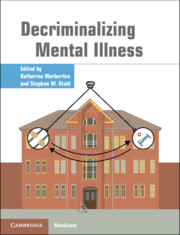Book contents
- Decriminalizing Mental Illness
- Decriminalizing Mental Illness
- Copyright page
- Contents
- Contributors
- Part I Introduction/Description of the Problem
- Part II Solutions
- Part III Psychopharmacological Treatment Considerations
- Chapter 18 Dopamine Antagonist Antipsychotics in Diverted Forensic Populations
- Chapter 19 Monitoring and Improving Antipsychotic Adherence in Outpatient Forensic Diversion Programs
- Chapter 20 Pharmacological Treatment of Violence in Schizophrenia
- Part IV Nonpsychopharmacological Treatment Considerations
- Part V Criminal Justice and Social Considerations
- Index
- References
Chapter 18 - Dopamine Antagonist Antipsychotics in Diverted Forensic Populations
from Part III - Psychopharmacological Treatment Considerations
Published online by Cambridge University Press: 19 October 2021
- Decriminalizing Mental Illness
- Decriminalizing Mental Illness
- Copyright page
- Contents
- Contributors
- Part I Introduction/Description of the Problem
- Part II Solutions
- Part III Psychopharmacological Treatment Considerations
- Chapter 18 Dopamine Antagonist Antipsychotics in Diverted Forensic Populations
- Chapter 19 Monitoring and Improving Antipsychotic Adherence in Outpatient Forensic Diversion Programs
- Chapter 20 Pharmacological Treatment of Violence in Schizophrenia
- Part IV Nonpsychopharmacological Treatment Considerations
- Part V Criminal Justice and Social Considerations
- Index
- References
Summary
In community settings, the principle barriers to independent living, stable relationships, and gainful employment arise from the negative and cognitive symptom domains of schizophrenia spectrum disorders., In contrast, the positive symptoms of psychosis often are the gateway (e.g. via persecutory delusion associated with anger) to arrest and criminalization for the mentally ill. Since the clinical discovery of chlorpromazine in 1952, dopamine antagonism in the mesolimbic dopamine circuit has been central to treating the positive symptoms of psychosis. The hyperactivity of the mesolimbic circuit and the normalizing effects of the dopamine antagonist antipsychotics are illustrated in Figure 18.1.
- Type
- Chapter
- Information
- Decriminalizing Mental Illness , pp. 191 - 199Publisher: Cambridge University PressPrint publication year: 2021



